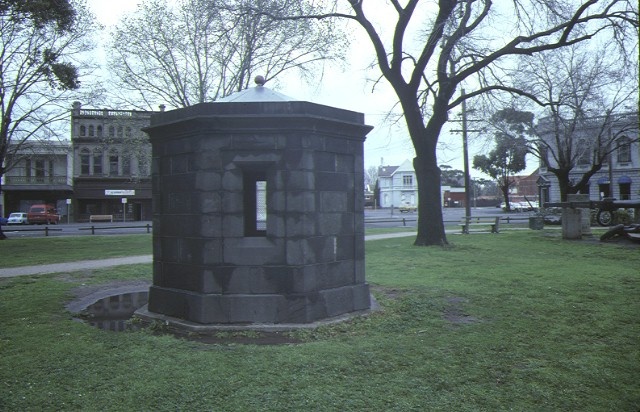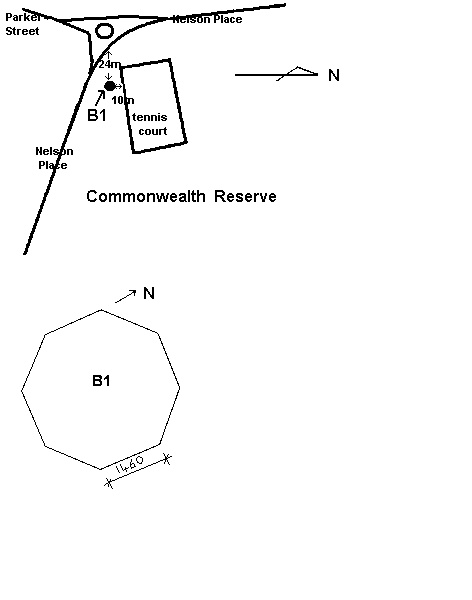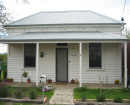TIDE GAUGE HOUSE
COMMONWEALTH RESERVE, NELSON PLACE WILLIAMSTOWN, HOBSONS BAY CITY
-
Add to tour
You must log in to do that.
-
Share
-
Shortlist place
You must log in to do that.
- Download report




Statement of Significance
Tide Gauge House was constructed at Gellibrands Point in 1857 to house one of three tide gauges that arrived from England in 1855. The other two gauges went to Portland and Point Lonsdale. The Point Gellibrand gauge was set in a bluestone structure located on the leeward side of Breakwater Pier. The structure was built by convict labour and the bluestone was obtained from the quarry at Fort Gellibrand. The gauge operated through an aperture in the wooden floor. Tides were measured from here and Williamstown became the origin of the Australian Height Datum. The tide gauge continued to operate in this location until 1943 when silting up of the site reputedly interfered with its operation. It remained on Breakwater Pier until 1955 when the filling in of the boat harbour required that it be moved to its present site in the Commonwealth Reserve. Windows of the house were loopholed to allow warders supervising the convicts to train their muskets on them. The Tide Gauge House is situated in the Commonwealth Reserve near the intersection of Nelson Place with Parker and Cole Streets. It is an octagonal structure constructed of fine dressed bluestone and stands approximately three metres high and three metres in diameter. The Tide Gauge House was originally set on a battered base. Only the upper section of the structure survives and the tide gauge has been removed. The structure is capped by a parapet cornice and a galvanised roof with a wooden ball finial. The doorway is fitted with a metal gate and the four loopholed windows are fitted with metal bars.
How is it significant?
Tide Gauge House is of historical and architectural significance to the State of Victoria.
Why is it significant?
Tide Gauge House is of historical importance for its associations with the early history of Victoria. It is important for its associations with the tide gauge which was housed at Point Gellibrand was the datum for Victoria before the adoption of the Australian Height Datum. Tide Gauge House is important for its representation of the maritime history of Victoria and Williamstown?s pivotal role in early Victorian History.
Tide Gauge House is of architectural importance as a rare surviving example of a custom-built tide gauge house. It demonstrates early stone construction techniques.
-
-
TIDE GAUGE HOUSE - History
Contextual History:
Under the direction of Governor Bourke, Robert Hoddle laid out the plan for the area which had been formerly known as Gellibrand’s Point in March 1837 and Williamstown was born. Williamstown was to play an important role in the early days of the colony (Bach, Student Report 1997).
The 1850s at Point Gellibrand saw concentrated Government activity that at the time was possibly unsurpassed in its diversity in any other part of the state. In a ten year period point Gellibrand became the home of the first Government Observatory, the first place linked by telegraph to Melbourne, a major port area, a temporary prison, and it received the first major defence installation in the Colony. During the same period Williamstown was connected to Melbourne and Geelong by train and the point became a focus of Port activity with two major piers both serviced by railways (Allom Lovell & Associates, 1987, p.7).
Breakwater Pier was constructed as a timber breakwater with an embanked approach from 1859 to 1861 by contractors McKay and McDonald. The Pier which incorporated an earlier (1857) octagonal tide gauge house, was constructed over an existing stone pier which had been built by convicts in 1852-53. The pier structure was designed as a two level structure on the landward end to allow access to the tide gauge house on one level with the railway on the other level. The seaward end of the pier was a uniform height. The docking area was on the sheltered western side with ships using a series of sawtooth berths. The side of the pier was straightened in the 1880s and it was lengthened in 1933-34. The pier was remodelled in 1954 to take super tankers, at which time the tide gauge house was relocated the Commonwealth Reserve (H1088).
History of Place:
In 1855 three tide gauges arrived in Victoria from England. The gauges were to be erected at Gellibrand’s Point, Point Lonsdale and Portland Bay. The Point Gellibrand gauge was set in a bluestone structure located on the leeward side of Breakwater Pier. The structure was built by convict labour and the bluestone was obtained from the quarry at Fort Gellibrand . In January 1857 the Williamstown Chronical noted that ‘On this pier is built a tide house for the reception of an instrument which will determine the depth of water on the Bar at the entrance of the Yarra, or in any part of the Bay (Allom Lovell & Associates 1987 p.8).
Tides were measured from here and Williamstown became the origin of the Australian Height Datum.
The tide gauge continued to operate in this location until 1943 when silting up of the site reputedly interfered with its operation. It remained on Breakwater Pier until 1955 when the filling in of the boat harbour required that it be moved to its present site in the Commonwealth Reserve. The building was a gift to the Shire Counci (Allom Lovell & Associates, 1987 p.8).
The gauge operated through an aperture in the wooden floor. The original cartwheel roof was destroyed by fire some years ago, but was restored. The restoration included a replica of a ball finial which had been missing for a long time. Windows of the house were loopholed to allow warders supervising the convicts to train their muskets on them (Evans, 1977 p. 22).TIDE GAUGE HOUSE - Assessment Against Criteria
Criterion A
The historical importance, association with or relationship to Victoria's history of the place or object.
Tide Gauge House is important for its association with the early development of the colony of Port Philip and Victoria. It is important for its association with Breakwater Pier, indicating its original appearance.
Criterion B
The importance of a place or object in demonstrating rarity or uniqueness.
Tide Gauge House is important as a rare surviving example of a custom-built tide gauge house.
Criterion C
The place or object's potential to educate, illustrate or provide further scientific investigation in relation to Victoria's cultural heritage.Criterion D
The importance of a place or object in exhibiting the principal characteristics or the representative nature of a place or object as part of a class or type of places or objects.
Tide Gauge House is important for its representation of the maritime history of Victoria and Williamstown's role in early Victorian History.
Criterion E
The importance of the place or object in exhibiting good design or aesthetic characteristics and/or in exhibiting a richness, diversity or unusual integration of features.
Tide Gauge House is of architectural importance as a rare surviving example of a custom-built tide gauge house. Constructed in 1857 it demonstrates early stone construction techniques and is representative of the early appearance of Breakwater Pier, the place at which it was originally constructed.
Criterion F
The importance of the place or object in demonstrating or being associated with scientific or technical innovations or achievements.
The Tide Gauge House is of technical importance for its associations with the establishment of the Australian Height Datum.
Criterion G
The importance of the place or object in demonstrating social or cultural associations.
The structure is of social and historical importance as it was constructed by convict labour and represents a phase in Victoria's history when convicts were housed in hulks moored off Point Gellibrand. Its retention and relocation when removed from Gellibrand Pier in 1955 is socially important as an early example of building preservation.
Criterion H
Any other matter which the Council considers relevant to the determination of cultural heritage significanceTIDE GAUGE HOUSE - Permit Exemptions
General Exemptions:
General exemptions apply to all places and objects included in the Victorian Heritage Register (VHR). General exemptions have been designed to allow everyday activities, maintenance and changes to your property, which don’t harm its cultural heritage significance, to proceed without the need to obtain approvals under the Heritage Act 2017.
Places of worship: In some circumstances, you can alter a place of worship to accommodate religious practices without a permit, but you must notify the Executive Director of Heritage Victoria before you start the works or activities at least 20 business days before the works or activities are to commence.
Subdivision/consolidation: Permit exemptions exist for some subdivisions and consolidations. If the subdivision or consolidation is in accordance with a planning permit granted under Part 4 of the Planning and Environment Act 1987 and the application for the planning permit was referred to the Executive Director of Heritage Victoria as a determining referral authority, a permit is not required.
Specific exemptions may also apply to your registered place or object. If applicable, these are listed below. Specific exemptions are tailored to the conservation and management needs of an individual registered place or object and set out works and activities that are exempt from the requirements of a permit. Specific exemptions prevail if they conflict with general exemptions.
Find out more about heritage permit exemptions here.
Specific Exemptions:
General Conditions:
1. All exempted alterations are to be planned and carried out in a manner which prevents damage to the fabric of the registered place or object.
2. Should it become apparent during further inspection or the carrying out of alterations that original or previously hidden or inaccessible details of the place or object are revealed which relate to the significance of the place or object, then the exemption covering such alteration shall cease and the Executive Director shall be notified as soon as possible.
3. If there is a conservation policy and plan approved by the Executive Director, all works shall be in accordance with it.
4. Nothing in this declaration prevents the Executive Director from amending or rescinding all or any of the permit exemptions.
5. Nothing in this declaration exempts owners or their agents from the responsibility to seek relevant planning or building permits from the responsible authority where applicable.
Exterior
*Minor repairs and maintenance which replace like with like.
*Removal of any extraneous items such as air conditioners, pipe work, ducting, wiring, antennae, aerials etc, and making good.
*Installation or repair of damp-proofing by either injection method or grouted pocket method.
Interior
*Painting of previously painted walls and ceilings provided that preparation or painting does not remove evidence of the original paint or other decorative scheme.
*Removal of paint from originally unpainted or oiled joinery, doors, architraves, skirtings and decorative strapping.
-
-
-
-
-
FORMER MORGUE
 Victorian Heritage Register H1512
Victorian Heritage Register H1512 -
WILLIAMSTOWN PRIMARY SCHOOL
 Victorian Heritage Register H1639
Victorian Heritage Register H1639 -
RESIDENCE
 Victorian Heritage Register H0487
Victorian Heritage Register H0487
-
"1890"
 Yarra City
Yarra City -
"AMF Officers" Shed
 Moorabool Shire
Moorabool Shire -
"AQUA PROFONDA" SIGN, FITZROY POOL
 Victorian Heritage Register H1687
Victorian Heritage Register H1687
-
'Altona' Homestead (Formerly 'Laverton' Homestead) and Logan Reserve
 Hobsons Bay City
Hobsons Bay City
-
-















